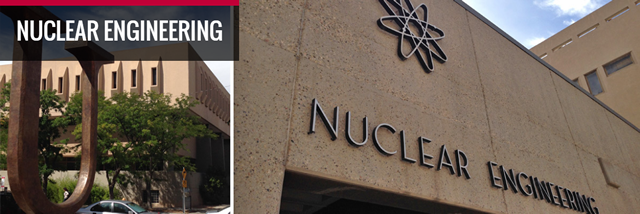
Nuclear Engineering ETDs
Publication Date
Summer 8-1-2022
Abstract
Lead cooled fast reactors have many potential economic advantages over other Generation IV reactor designs due to the high boiling point of lead (~1750 °C) at atmospheric pressure and excellent neutronic properties which have made them attractive to the commercial energy sector in the recent years. They, however, remain hampered by challenges in cladding material compatibility with the heavy liquid metal coolant. A forced circulation loop was established at the University of New Mexico (“Lobo Lead Loop”) to prequalify materials for Versatile Test Reactor (VTR) testing and to improve the understanding of flow accelerated corrosion in molten lead environment. Corrosion in lead cooled environment is understood to be predominantly a mass transfer problem that is exacerbated by erosion of protective oxide layers and lead penetration. Quantitative transfer of the out-of-pile experiments at the loop to reactor conditions is necessary for durability assessment of structural materials, safety analyses (e.g. to avoid clogging due to corrosion product precipitation), and validation of the current theoretical understanding of lead induced corrosion in reactor environment. Many empirical and physics-based models of corrosion have been introduced in the literature based on mass transport and oxide layer modeling but with limited out-of-pile application and no application in reactor conditions due to the difficulty of obtaining inputs to these models (e.g. oxide layer thickness and composition, transport coefficients especially in oxide layers, reactor temperature distribution and flow conditions). The present work aims to support out-of-pile experiments in the Lobo Lead Loop and lay the foundation for efforts to study corrosion in reactor conditions and transfer the out-of-pile experiments to reactor conditions, within a proposed framework. The proposed framework involves coupling of experiments with computational fluid dynamics simulations of the flow to enable the development of multivariate correlations, molecular dynamics simulations to estimate transport coefficients, and neutronics-thermal hydraulics coupling for transfer of the experiments to reactor temperature distribution and flow conditions.
Computational fluid dynamics simulations are utilized to study the flow conditions in the loop, design components to meet experimental operation targets, and examine shear stresses on the specimens to inform erosion modeling efforts which can be pursued after the experiments are conducted. Lagrangian-Eulerian coupled simulations are used to study convective mass transport to understand how the convective properties of lead differ from other coolants such as Lead-Bismuth eutectic, sodium, and water. The simulations also explore sensitivity of convective transport to surface roughness of the specimens, temperature of lead, and mean flow velocity. It is then proposed that the coupling between neutronics and mass transport can be leveraged to monitor and study corrosion of cladding materials in reactor conditions. The simulations employed a TRIGA model that was modified to be lead cooled and demonstrated that positive reactivity is added due to mass transfer corrosion which removes nickel and other absorbers from the active core. This proposed approach to be made practical, however, necessitates that reactivity and neutronics contributions from other sources (e.g. temperature distribution changes and burn up) be discerned from relatively small mass transfer contributions which necessitates advanced multi-physics coupling. A platform is developed for geometry-blind, multi-server steady state coupling of prompt neutronics (MCNP6.1) and thermal hydraulics (OpenFOAM/STAR-CCM+) which accounts for effects of power distribution from neutronics on heat transfer in the simulated system and accounts for effects of temperature of densities, surface expansion, and Doppler broadening of cross-sections through MAKXSF. As data on transport coefficients needed for mass transfer modeling and thermal hydraulics simulations, particularly in oxide layers that form with varying thickness and composition, remains scarce, molecular dynamics simulations were proposed as part of the framework. Non-equilibrium molecular dynamics simulations are preferred for their ability to study size effects at the nano and low-micron scales. As an effort to improve the reliability of molecular dynamics simulations, the method of Shannon entropy for convergence assessment of the fission source distribution in Monte Carlo neutron transport in MCNP is adapted and introduced to molecular dynamics. Application of the approach to simulations of thermal conductivity, radiation damage, and fluid flow shows potential for generalization to other areas of molecular dynamics.
Keywords
lead cooled reactors, flow accelerated corrosion, LOBO Lead Loop, multi-physics coupling, mass transfer modeling, molecular dynamics
Document Type
Dissertation
Language
English
Degree Name
Nuclear Engineering
Level of Degree
Doctoral
Department Name
Nuclear Engineering
First Committee Member (Chair)
Osman Anderoglu
Second Committee Member
Minghui Chen
Third Committee Member
Forrest Brown
Fourth Committee Member
Blas P. Uberuaga
Recommended Citation
Talaat, Khaled A.. "Computational Methods, Investigations, and Codes to Support Corrosion Experiments in Molten Lead and Transfer to Reactor Conditions." (2022). https://digitalrepository.unm.edu/ne_etds/107


